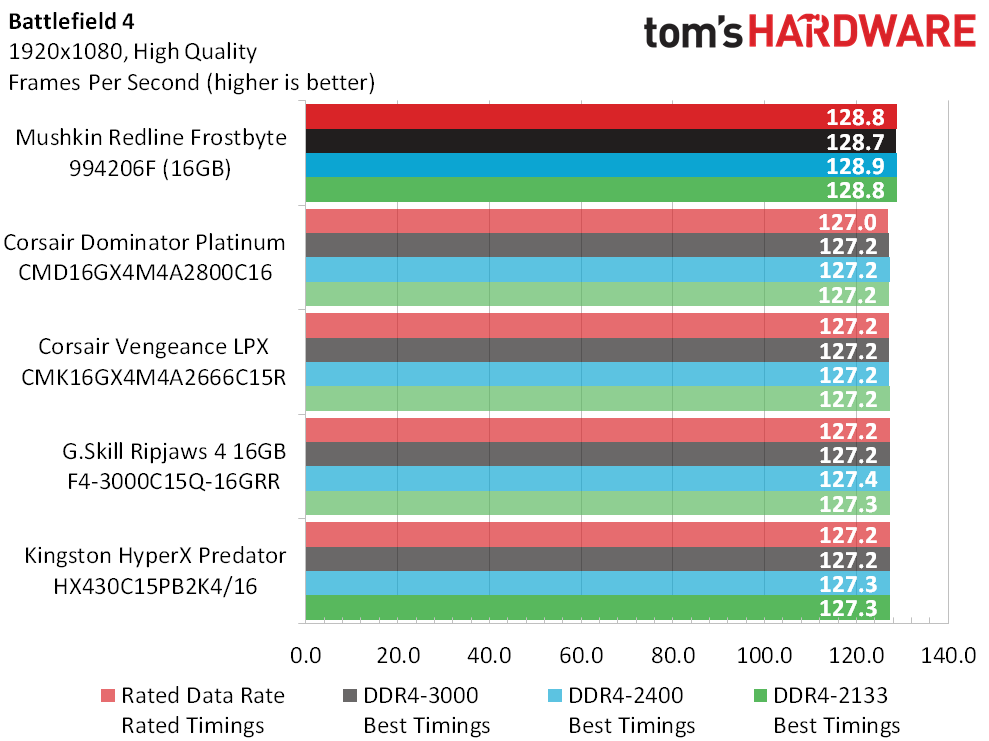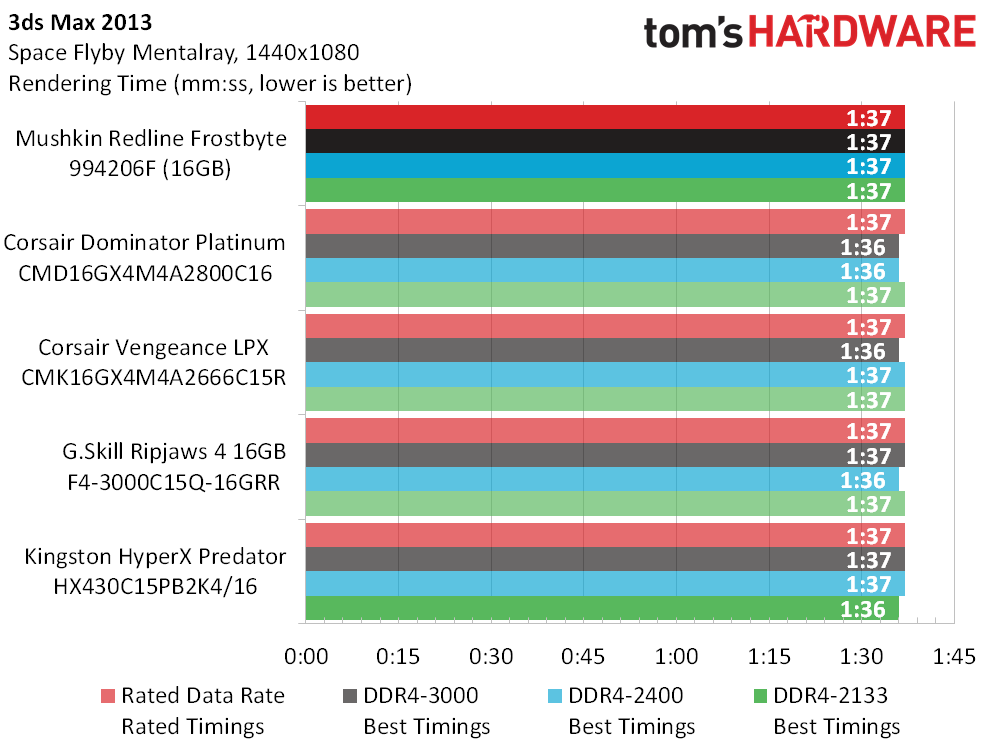Mushkin Redline Frostbyte 16GB DDR4-2800 Review
Why you can trust Tom's Hardware
Results And Analysis
Retained hardware and software from our initial DDR4 round-up allows us to compare every DDR4 kit reviewed, without retesting. Almost as important is that I can show the link, rather than repost a bunch of redundant setup tables. We’ll jump straight to the point!
Intel’s higher memory multipliers are less stable than the more familiar validated settings, and the easiest way to get a more aggressive data rate with a lower memory multiplier is to use an elevated base clock. The CPU's 1.25x strap allows the parts that can’t be overclocked very far to run at 100MHz while the CPU core and memory controller operate at 125MHz. Memory multipliers that would normally correspond to DDR4-2400 and DDR4-2666 at 100MHz BCLK become DDR4-3000 and DDR4-3333 at 125MHz.
No memory we’ve reviewed thus far has been stable at a 3333 MT/s data rate, and our CPU becomes unstable at BCLK frequencies beyond 132MHz (corresponding to a 3168 MT/s data rate). Filling the hole between 3168 and 3333 requires underclocking the 125MHz BCLK, which would be silly if not for the fact that it exposes the true limits of each memory kit. In this case, Mushkin’s DDR4-2800 overclocks only one test setting lower than G.Skill’s highly-praised DDR4-3000.
Redline 994206F also overclocks one test setting higher than Corsair’s high-priced Dominator Platinum, though the price of those premium parts includes fancier heat spreaders and its Airflow Pro activity and temperature monitoring interface.
Manually configuring the Redline 994206F kit to its lowest stable primary timings, we see it mirrors Corsair’s Dominator Platinum, which has a similar DDR4-2800 rating. G.Skill's DDR4-3000 modules lead slightly.
Mushkin’s tiny lead over its DDR4-2800 rival continues through Sandra's Memory Bandwidth test, though only at default XMP frequency and timings.
The Mushkin difference is its default XMP latency. Corsair’s CAS 16-18-18-36 is designed for easy booting, while Mushkin’s 15-15-15-35 pushes performance hard right out of the gate. Since both kits support identical optimized values, I’d say that either Corsair was being cautious or Mushkin reckless. I’d love to hear your opinion in the response thread.
Get Tom's Hardware's best news and in-depth reviews, straight to your inbox.




The Redline 99420F kit falls slightly behind under Grid 2’s most memory-sensitive settings, though I don’t know anyone who could see the actual difference between 231 and 234 FPS. Other benchmarks are mostly tied. I’d love to hear suggestions for another popular real-world application that I should add to the test suite.
A chart that shows actual performance for each memory kit, divided by the average performance of all four kits, divided by price, shows that Mushkin’s Redline 994206F achieves roughly the same value as G.Skill’s DDR4-3000. This happened only after G.Skill radically reduced the price of its premium kit. The current $5 delta raises the question of who I should recognize most prominently?
G.Skill’s recent price reduction sets up a conflict that I won’t be able to resolve to anyone’s satisfaction. Is it fair to award one product in the review of another? Would it be fair not to equally award products of equal standing? And how can I recommend two products to fill exactly one role in exactly one system? I’ll try to answer this, to no one’s satisfaction: We recommend that buyers choose between Mushkin 994206F and G.Skill 3000C15Q kits based on the current price at their favorite vendor, their favorite brand for support and their ability to configure custom settings.
-
mapesdhs I liked the Mushkin kits I've bought in the past (not quite as good asReply
GSkill, but pretty decent), but the big down side of Mushkin, at least in
the UK, is availability. Aria seems to be one of the few sellers that stock
their products, in my case making it very difficult at one point to upgrade
a system with another kit since nowhere had them available. By contrast,
GSkill is much easier to find. Overall, I'd recommend GSkill over Mushkin
for this reason alone, but GSkill does tend to be cheaper anyway here.
Ian.
-
Crashman See Ian, you're the perfect example of why I couldn't pick just one recommendation at or near this price/capacity :)Reply -
ingtar33 I've owned a serious of excellent gskill kits, and excellent mushkin redline kits.Reply
I don't think anyone would go wrong with either. -
Kewlx25 Mushkin, G.Skill, and Corsair are my fav brands. I don't think anything they make is bad, even outside of memory.Reply -
JackNaylorPE "Since both kits support identical optimized values, I’d say that either Corsair was being cautious or Mushkin reckless. I’d love to hear your opinion in the response thread."Reply
How about what's inside ? I see GPU reviews, PSU reviews, MoBo reviews where the unit is torn down and each part identified ..... how come reviewers don't look at whose modules are used ? I think that might just answer your question above.
One thing I noticed with DDR3-2400 was that Corsair VPs, Corsair Dominators and Muskin RL's both marketed sets for some time with 10-12-12-28 timings .... I had opened up both the VPs and RLs and both used Hynix modules. Then after a while, the VPs dropped to 10-12-12-31 and in searching for the reason behind the drop, I found out that (after version 4.51 IIRC), Corsair switched module suppliers. Mushkin still continues to offer 10-12-12-28 and I can personally confirm that they are still Hynix modules. Soon after the Dominators, also dropped to 10-12-12-31 leading me to believe they also switched suppliers.
My assumption at the time was that they each used Hynix in early years while production lines were young to maintain desired yields, but as lines matured and yields started to exceed demand, it made sense to switch to less expensive modules.
So.,.. to answer ya question, one of the possible reasons for the different performance observed could be eliminated if ya popped off the heat sinks and identified whose modules are underneath.
When I see DICE / LN2 users looking for those record breaking OCs, one of the things usually found in the siggies is RAM w/ Hynix modules at crazy voltages ... highest i can remember for DDR3 was 1.94
-
cynic77 Interesting comparisons in the article. I've been holding out for a 64 GB kit of DDR4-2800 Corsair Dominators... now I'm not so sure that would be a wise play.Reply
Since DDR4 is relatively new and I've got an ASUS board, I've been looking at the supported memory spreadsheet (in PDF) that ASUS publishes on a regular basis. Unfortunately, my conclusion is that it's almost useless. There are Corsair models in it that don't even exist! (There are no Mushkin models listed, btw.) I suppose they can't claim you fried your motherboard because of using unsupported RAM if their list of supported modules isn't relevant, right? -
Crashman Reply
I wouldn't go beyond DDR4-2666 with eight modules right now, due to poor support of higher speeds by the memory controller. DDR4-2800 at 100 MHz BCLK is only stable under ideal conditions, and anything else higher than 2666 has you looking at a 125 MHz BCLK, by default.15522995 said:Interesting comparisons in the article. I've been holding out for a 64 GB kit of DDR4-2800 Corsair Dominators... now I'm not so sure that would be a wise play.
Since DDR4 is relatively new and I've got an ASUS board, I've been looking at the supported memory spreadsheet (in PDF) that ASUS publishes on a regular basis. Unfortunately, my conclusion is that it's almost useless. There are Corsair models in it that don't even exist! (There are no Mushkin models listed, btw.) I suppose they can't claim you fried your motherboard because of using unsupported RAM if their list of supported modules isn't relevant, right?
I'd actually prefer DDR4-2400 for eight modules, because it doesn't get stuck with weird XMP settings. There's still lots of room to optimize timings for exceptional performance at that data rate.
-
Jake W It's interesting that Tom's is recommending the 2800 rating Redline as the "ultimate value" choice when the 16GB DDR4-3000 rated Redline is only $4 more on New Egg. (It's actually cheaper than the Amazon price for the 2800.)Reply
That being said, I'm glad to see this as I just purchased the aforementioned 16GB DDR4-3000 Redline Frostbyte for my new X99 build! =) -
Crashman Reply
It's about results, regardless of rating. Mushkin's DDR4-3000 might be superior, but if they didn't send any how would a tester know?15524032 said:It's interesting that Tom's is recommending the 2800 rating Redline as the "ultimate value" choice when the 16GB DDR4-3000 rated Redline is only $4 more on New Egg. (It's actually cheaper than the Amazon price for the 2800.)
That being said, I'm glad to see this as I just purchased the aforementioned 16GB DDR4-3000 Redline Frostbyte for my new X99 build! =)
There are two awards at the end of the article, the other is for the baseline G.Skill DDR4-3000 to which is was compared. The kits are virtually identical. Both have the best value in overclocking of any kits tested.
A completely different product could have easily gotten this award if it had been submitted, it's just that simple (submit top kit at ordinary price, get award).
-
JackNaylorPE Reply15524095 said:It's about results, regardless of rating. Mushkin's DDR4-3000 might be superior, but if they didn't send any how would a tester know?
There are two awards at the end of the article, the other is for the baseline G.Skill DDR4-3000 to which is was compared. The kits are virtually identical. Both have the best value in overclocking of any kits tested.
A completely different product could have easily gotten this award if it had been submitted, it's just that simple (submit top kit at ordinary price, get award).
What are the chances of these types of articles identifying the module supplier in the future ?








